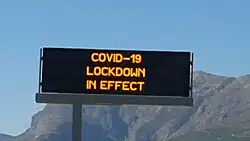COVID-19 lockdown in South Africa

The COVID-19 lockdown in South Africa was a series of stay-at-home orders introduced by the South African Government in response to the COVID-19 pandemic.
In January 2020, the World Health Organization (WHO) declared a global health emergency. [1]The South African Government responded quickly with a public health response that included nationwide lockdowns. On 23 March 2020, President Cyril Ramaphosa announced a nationwide lockdown (under the disaster management act) to prevent the spread and widening of COVID-19 outbreak. A national lockdown was announced, starting on 26 March (at midnight) to 16 April 2020.[2] The country began a hard lockdown (later categorized as Alert Level 5), as a precautionary measure. [3]
| Alert Level | Description[4] |
|---|---|
| 1 | indicates a low Covid-19 spread with a high health system readiness; |
| 2 | indicates a moderate Covid-19 spread with a high health system readiness; |
| 3 | indicates a moderate Covid-19 spread with a moderate health system readiness; |
| 4 | indicates a moderate to a high Covid-19 spread with a low to moderate health system readiness; |
| 5 | indicates a high Covid-19 spread with a low health system readiness. |
The first local death from the disease was reported on 27 March 2020.[5] Lockdowns and social distancing were seen as a tool by governments to contain transmission and curb the spread of the disease. The initial lockdown was initially intended to last 21 days, from midnight of the 26th of March to 16 April 2020. [6] This lockdown period was then extended to 35 days, up to 30 April 2020. During the Level-5 lockdown, all were told to “stay home” and remain indoors at all times. Those who were essential service workers were permitted to travel. [7] Access to many commercial food and beverage services were closed during the lockdown.[8] Realising the economic impact the hard lockdown n the economy, President Ramaphosa announced a R500 billion economic recovery plan.[9]
Many South African citizens responded positively to the limitation of their normal rights, in order to secure health and safety for all[10] and preventing the spread of the virus further and the wearing of a face mask in public places became common practice, despite ambiguous regulations. [11]
By January 2022, South Africa had reported 93 000 fatalities.[1]
References
- ^ a b "Strengthening South Africa's COVID-19 preparedness and response: Building sub-national capacities and resilience through coordinated actions". www.who.int. Retrieved 2025-08-07.
- ^ "Ramaphosa announces 21 day coronavirus lockdown for South Africa". businesstech.co.za. 23 March 2020. Archived from the original on 3 July 2020. Retrieved 23 March 2020.
- ^ "Lockdown didn't work in South Africa: why it shouldn't happen again | PreventionWeb". www.preventionweb.net. 2020-10-15. Retrieved 2025-08-07.
- ^ "About alert system | South African Government". www.gov.za. Retrieved 2025-08-07.
- ^ "Minister Zweli Mkhize confirms total of 1170 cases of Coronavirus COVID-19". Government of South Africa. 2020-03-27. Retrieved 2021-08-26.
- ^ https://www.cogta.gov.za/cgta_2016/wp-content/uploads/2020/03/Final-lockdown-regulations-1.pdf
- ^ Voigt, Elri (2020-03-26). "COVID-19: What you may and may not do during South Africa's 21-day lockdown". Spotlight. Retrieved 2025-08-07.
- ^ Voigt, Elri. "Covid-19: What you may and may not do during 21-day lockdown in SA". News24. Retrieved 2025-08-07.
- ^ Tromp, Beauregard (2020-04-21). "Ramaphosa announces R500-billion Covid-19 package for South Africa". The Mail & Guardian. Retrieved 2025-08-07.
- ^ Roberts, Narnia Bohler-Muller and Benjamin (2021-05-06). "Ubuntu: COVID-19 and human rights sacrifice in SA". Spotlight. Retrieved 2025-08-07.
- ^ "Can you be arrested for not wearing a face mask? The dangers of vague regulations". News24. Retrieved 2025-08-07.